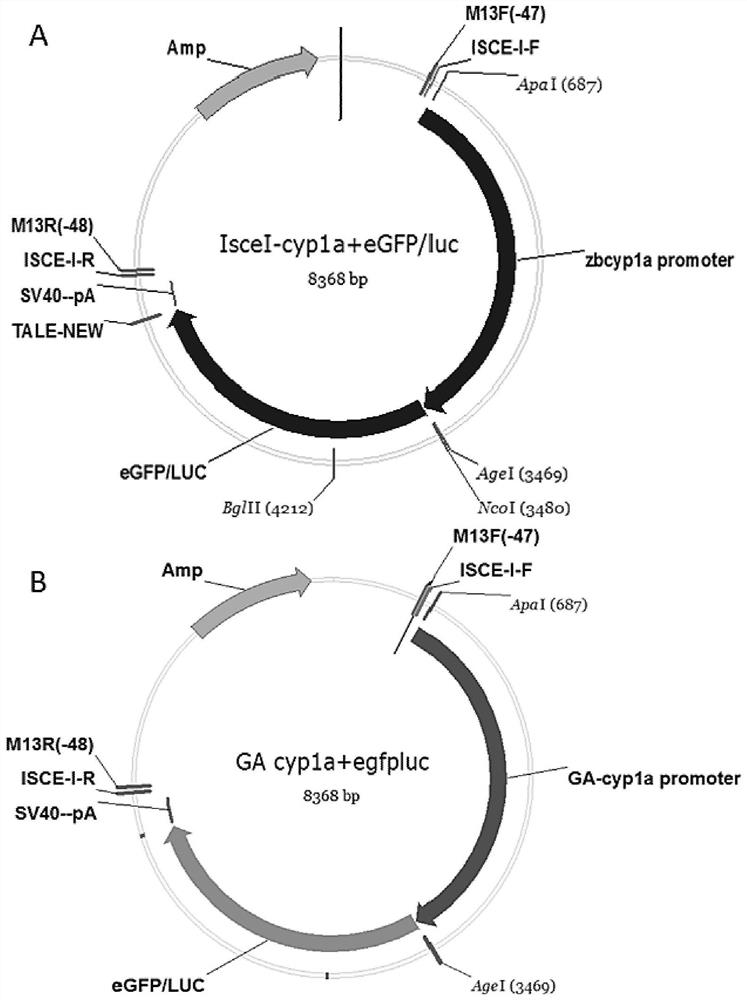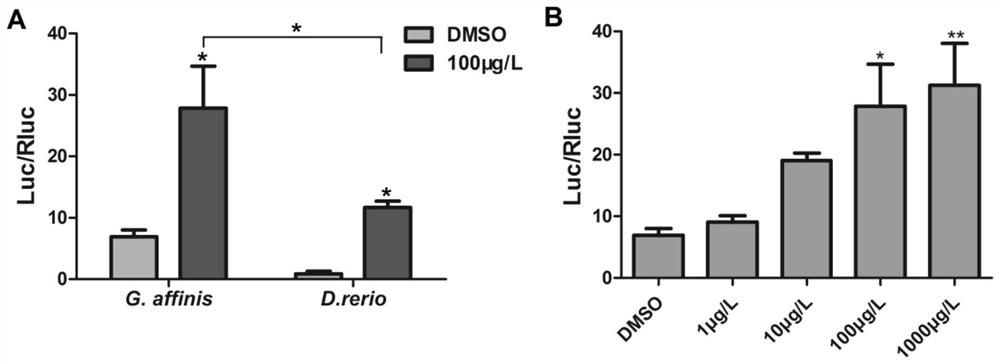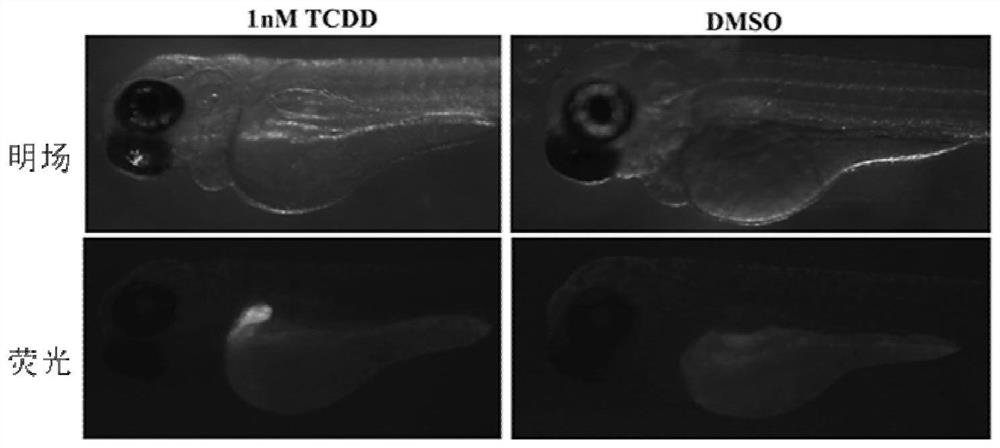Cultivation method of transgenic zebrafish for detecting organic pollutants in water body
A technology of organic pollutants and zebrafish, which is applied in the fields of plant genetic improvement, botany equipment and methods, biochemical equipment and methods, etc. The effect of high sensitivity and high luciferase activity
- Summary
- Abstract
- Description
- Claims
- Application Information
AI Technical Summary
Problems solved by technology
Method used
Image
Examples
Embodiment 1p
[0053] Example 1 Preparation of pISceI-GAcyp1apromoter-eGFP / Luc plasmid
[0054] (1) Genomic DNA Extraction of Mosquito Fish
[0055] Mosquito fish were taken, 20-30 mg of caudal fins were cut, rinsed several times in distilled water, blotted dry with absorbent paper, placed in a 1.5 mL centrifuge tube, cut into pieces, and extracted according to tissue DNA kit (purchased from Tiangen Biochemical Technology (Beijing, China). ) Co., Ltd.) to extract the mosquito fish genome DNA.
[0056] (2) Amplification primer design
[0057] According to the sequence of the coding region of the mosquito fish cyp1a gene (Gene ID: MK286594.1) searched on NCBI, its cyp1a promoter sequence was retrieved from the mosquito fish genome database (GCA_019740435.1), and the upstream amplification primer GAcyp1a was designed -F: 5'-GAACCATAGGGAAGATTGCTGACAT-3', downstream amplification primer GAcyp1a-R: 5'-AAATAAAGTCAAGCATCATAGAATCATC-3'.
[0058] (3) PCR amplification of the mosquito fish cyp1a gen...
Embodiment 2p
[0073] Example 2 Functional identification of pISceI-GAcyp1apromoter-eGFP / Luc plasmid
[0074] 1. Experimental method
[0075] (1) Cell culture
[0076] Human liver cancer cell HepG2 was used to verify the effect of fluorescence induction.
[0077] Human hepatocellular carcinoma cells HepG2 were treated with 1×10 4 Cells / well were inoculated into 96-well cell culture plates, and cultured in high-glucose DMEM medium cultured with serum and without antibiotics.
[0078] (2) Cell transfection
[0079] After the HepG2 cells in the above-mentioned 96-well plate grow to a fusion rate of 70-80%, use the Promega ViaFectTM transfection reagent to transfer the pISceI-cyp1apromoter-eGFP / Luc plasmid (SEQ ID NO.2) and the pISceI-GAcyp1apromoter-eGFP / Luc plasmid (SEQ ID NO.4), respectively with Renilla luciferase control plasmid (from Promega dual luciferase assay kit Luciferase Assay System) were co-transfected into HepG2 cells.
[0080] The HepG2 cell that transfected pISceI-cyp1ap...
Embodiment 3
[0089] Preparation and screening of embodiment 3 transgenic zebrafish
[0090] 1. Experimental method
[0091] (1) Preparation of bodyless zebrafish
[0092] According to the 5'UTR region of the zebrafish mitfa gene (Gene ID: ENSDARG00000003732), six targeting sites for the CRISPR / CAS9 gene editing system were designed and named mitfa-1-6. The specific sequences are as follows:
[0093] mitfa-1:5'-CTTCAGCTGGCCAAGACGAC-3';
[0094] mitfa-2: 5'-CAAGAACTGACCAGTCGTCT-3';
[0095] mitfa-3: 5'-GCTCGAGTACAGTCACTACC-3';
[0096] mitfa-4:5'-CAGTCACTACCAGGTGAGAT-3';
[0097] mitfa-5 (SEQ ID NO.5): 5'-GACACAAAATGTATTTAAGG-3';
[0098] mitfa-6: 5'-ACAAAATGTATTTAAGGGGG-3'.
[0099] Among them, mitfa-5 (SEQ ID NO.5) has the highest targeting efficiency and is used as the targeting site for the final insertion mutation sequence.
[0100] Using the CRISPR / CAS9 gene editing system, through homologous recombination, a random sequence (SEQ ID NO.8) was inserted between the promoter and th...
PUM
 Login to View More
Login to View More Abstract
Description
Claims
Application Information
 Login to View More
Login to View More - R&D
- Intellectual Property
- Life Sciences
- Materials
- Tech Scout
- Unparalleled Data Quality
- Higher Quality Content
- 60% Fewer Hallucinations
Browse by: Latest US Patents, China's latest patents, Technical Efficacy Thesaurus, Application Domain, Technology Topic, Popular Technical Reports.
© 2025 PatSnap. All rights reserved.Legal|Privacy policy|Modern Slavery Act Transparency Statement|Sitemap|About US| Contact US: help@patsnap.com



